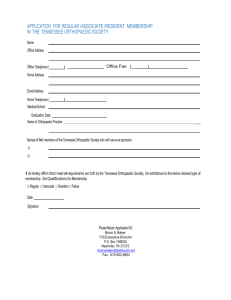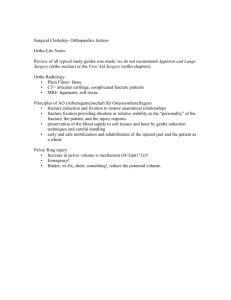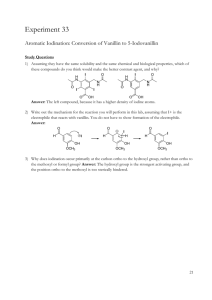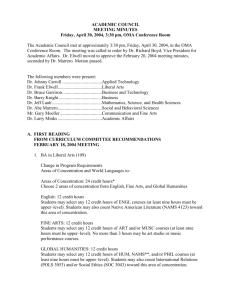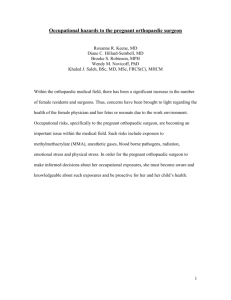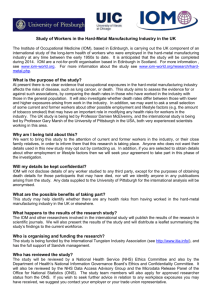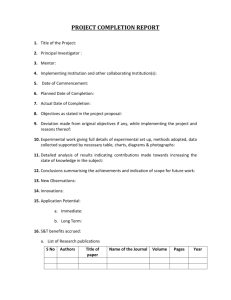Training of Orthopaedists – Nepal Scenario
advertisement
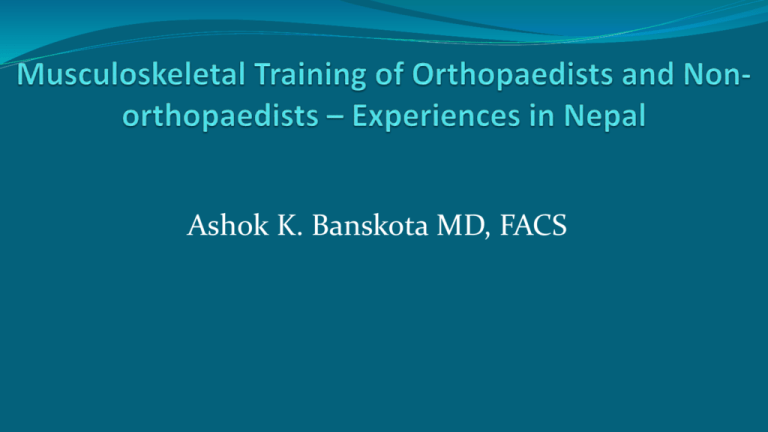
Ashok K. Banskota MD, FACS Training of Orthopaedists Under Ministry of Education & Sports Tribhuvan University (TU) Kathmandu University (KU) • Under Ministry of Health & Population – BP Koirala Institute of Health Sciences (BPKIHS) – National Academy of Medical Sciences (NAMS) Trends in Post Graduate Program Development IOM, (TU)MBBS Higher Studies 1979 1982 (PG) 1998 (Ortho) KU 1994 1999 (Ortho) 1994 1998 (Ortho) NAMS (PG Institute) 2003 (Ortho) BPKIHS Course Duration ALL Pre Requirement 1yr House officer, Post MBBS NMC Registration IOM (TU BPKIHS KU NAMS 4 yrs 3 yrs 3 yrs* 3 yrs** Global Objectives Meet increasing specialist manpower need Produce a skilled orthopaedic specialist of at least minimum international standards Provide a training experience with an adequate knowledge base of the applied basic sciences, trauma care principles and management of common orthopaedic disorders. Candidate Selection Criteria Slated Criteria All Entrance Examination for pre qualifiers Interview Special Circumstances Accommodating diploma Holders (NAMS) Scholarships (Foreigner) Manpower needs of training institutions (KU) BPKIHS (meeting National manpower needs) Costs of Training • • • • IOM KU BPKIHS NAMS University Expenses Student – monthly stipend Training institution logistic expenses Expenses for Special courses / meetings Challenges in Orthopaedic Care – Nepal Specialist needs enormous 90 orthopaedists / 26 million No uniformity in standards of practice – trainees from different backgrounds Practice opportunities limited – enormous input required throughout the country Kathmandu University – Ortho Residency (1999) MS – B & B Hospital + Hospital and Rehabilitation Center for Disabled Children (HRDC) Initiated to meet growing needs compliment of case load / institutional base / preceptors Controversies – (now resolved) 1999-2006 : 11 graduates 10 Lakhs Pre-Residency University Program 1 year 3 years E X A M Registrar 1 year IOM – TU PG Ortho (1998) TUTH – Venue Foreign nationals / Paying 4 years course Intake initially 2/year now 4/year Criteria: Entrance Exam Passed out : 15 Cost 10 Lakhs BPKIHS – Ortho 1998 Medical University – 3 year Program Central Government of India collaboration Apex institute for manpower training Intake initially 2/year now 4/year (foreign nationals) Total passed out : 16 Cost : 10 – 14 Lakhs NAMS – Ortho (2003) Bir Hospital (PG Institute) Valley Group of Hospitals Accommodation of Diploma Holders in Government Positions Capitation students (local + Foreign) also taken Intake 6 (regular – 3, diploma -1, sponsor-1, foreign -1) Passed out 12 Cost : 8 Lakhs Orthopaedic Graduates from 1998 to 2007 20 15 15 11 16 12 10 5 0 KU NAMS IOM BPKIHS PG Orthopaedic Training – Nepal Scenario Government & Non Government Participation Course Objectives similar Duration of training variable Training experience ununiform except for truama Evaluation systems not tested nor reviewed Student / Teacher ratio 1:1 Teachers: making use of available manpower often lacking experience. Training Process – Documentation Core logbook To maintain records of the acquisition of skills To indicate the levels of competence expected & achieved Thesis Training Program – Common Patterns IOM BPKIHS KU NAMS Group discussions Case Presentations Journal Clubs Practical Learning ER OPD OT Clinical Research Hours / Duties / Time off No Hours 80-90 hrs/week Training Program – Special Aspects KU – Additional Pediatric & Rehabilitation Exposure BPKIHS Community orthopaedics Link with AIIMS & other leading Indian Institutions Evaluations Formative Evaluation Applied Basic Sciences Clinical Presentations Annual Examinations Dissertation (Thesis) Final Examination Written : I, II & III Practical Examiners Examinations Paper setting as per guidelines of university Chairman – appointed Written papers Practical OSCE Short and long cases Table viva Examinations – Shortcomings Uniformity lacking – Specially in implementation Pre-tests of examinations ? Validity to need and training ? Bias – competitive / institutional Roles of Non-Orthopaedists Initial evaluation/primary care/emergency care Transport Definitive care Health Assistant (HA) Course Duration : 2 ½ years to 3 years 11 centers and 40 intake in each center Course content: Basic Science Basic Medicine Basic Surgery Basic epidemiology Maternal Child Health Immunization First Aid Surgery Preventive Health Referral Job Posting : Health Post Job Responsibility Community Medical Assistant (CMA) Course Duration : 15 months Course content: Basic Science Basic Medicine First Aid Surgery Basic epidemiology Maternal Child Health Immunization First Aid Preventive Health Referral Job Posting : Sub Health Post Job Responsibility Community Based Rehabilitation (CBR) Worker -(HRDC) Stationed in the field HRDC need based Primary selection and intensive 3 months long training with annual 6 weeks refreshers. Goals – preventive, facilitative, screening, referral, Rx Physiotherapy and Rehabilitation (PRT)Trainee- (HRDC) Pre requirement – High School Training Didactic/Practical Community Need based Follow up care / rehabilitation needs of patients emphasized Other Non-Orthopaedist Workers Compounder/Dresser Plaster cast technician Ambulance Driver/attendant Traditional practitioners, including bone-setters, barbers Conclusions: Orthopaedists 1. 2. 3. 4. 5. 6. Curriculum needs to have a practical focus, instead of trying to be “complete”. Uniformity in training experience should be a continuous target. Cost effective non-operative treatment methods need to be promoted. Technically, market driven orthopaedic practices, may give wrong message to trainee. Case material for training can be pooled from all the available institutions to strengthen a broad exposure Areas that need strengthening 1. Evaluations Process 2. Research and Publications 3. Availability of special courses in weaker areas. Conclusions: Non-Orthopaedists Important but largely neglected manpower 2. Very simple and basic training can be cost effective. 3. Serious complications/fatalities would be prevented. 4. Curriculum design and urgent implementation is the need of the day 1.
